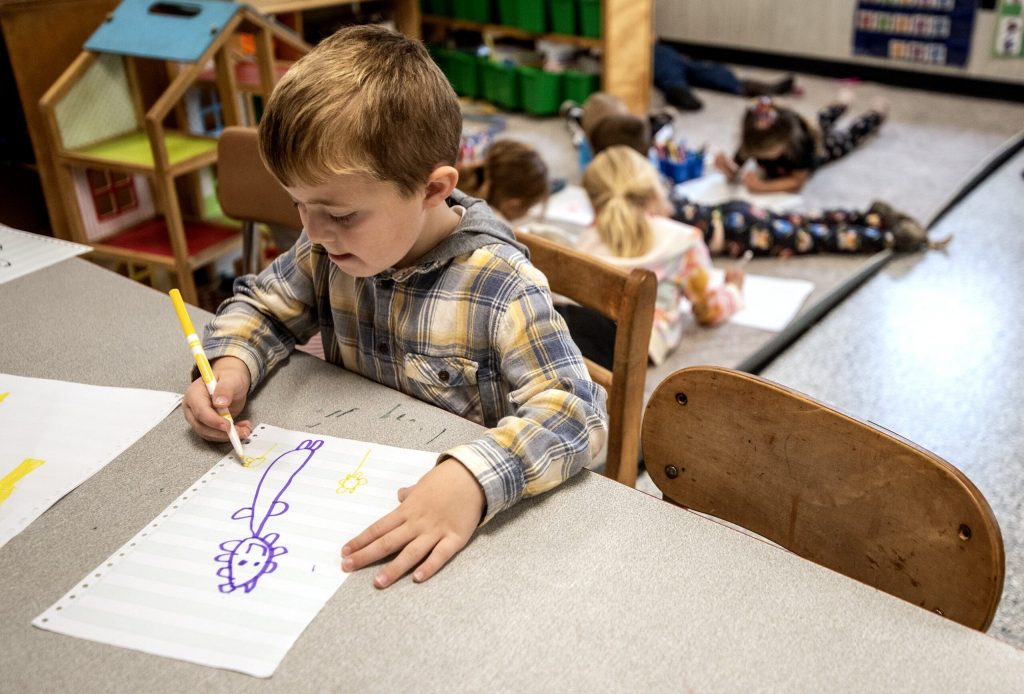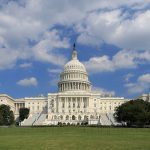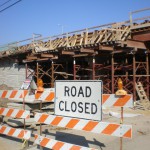Wisconsin Public School Funding Falls Further Behind National Average
New report finds big decline since 2002, state now 10% behind national average.

A preschool student draws in a classroom on Friday, Oct. 27, 2023, at Wee Care Child Center in Waupun, Wis. Angela Major/WPR
When adjusted for inflation, Wisconsin’s per-pupil spending on public school students continues to fall behind the national average, according to U.S. Census data analyzed by the Wisconsin Policy Forum. The most recent figures show the state was nearly 10 percent below the national average in 2023.
The Policy Forum report shows Wisconsin spent $14,882 on each student two years ago when inflation is taken into account. That figure represents a 2.4 percent increase since 2002. During the same period, the national average grew by around 21 percent, from $13,043 in 2002 to $16,526 in 2023.
Wisconsin’s per-pupil spending ranked 26th in the nation, according to the 2023 census data. In 2002, when the census first started collecting school funding data, Wisconsin ranked 11th in the nation.
“That, I think, is the consequence of a lot of choices that our state policy makers have made over many state budgets over the last decade-plus,” said Policy Forum Researcher Mark Sommerhauser.
The Policy Forum data also analyzed Wisconsin’s education spending as a share of residents’ combined personal incomes and found it’s fallen faster than the national average. In 2002, the state’s share was around 4.5 percent, which was higher than the national average of 4 percent at the time. In 2023, Wisconsin’s share fell to about 3.3 percent, while the national rate was 3.5 percent.
The analysis cites several reasons for Wisconsin’s lagging school spending as it compares to the national average. Those include GOP lawmakers’ decision in 2011 to decrease school revenue limits by 5.5 percent in the 2011-2012 state budget, and a prioritization of lowering the state and local tax burden.
“Our analysis makes clear that Wisconsin’s national rank on education spending continues to decline,” said the report. “To a greater extent than other states, Wisconsin also is spending a declining share of income earned by its residents on education. Other policy interests like reducing the tax burden on state residents appear to have taken priority.”
The Forum analysis suggests another critical factor is enrollment declines. Nationally, enrollment has fallen by 1.3 percent between 2002 and 2023, the report shows. In Wisconsin, it’s dropped by 7.3 percent in that time. The report said that could actually make the state’s per-pupil spending level look better than if enrollment had held steady over the past two decades.
There are factors the Policy Forum report suggests could alter Wisconsin’s school spending trajectory, like Democratic Gov. Tony Evers’ 2023 partial state budget veto, which extended a $325 per-pupil revenue limit increase through the year 2425. The current state budget, signed into law July 3, also increases state funding to schools for special education by more than $500 million over the next two years. And, voters across Wisconsin approved a record number of school district referendums in 2024, which authorizes districts to raise local property taxes above state revenue limits.
“Together, these decisions could provide districts with additional resources that, in future years, could mean that Wisconsin regains some ground or holds steady in comparison with the U.S. average,” the Policy Forum report said.
However, Sommerhauser said, school referendums and new authority for schools to raise property taxes to bring in new money also adds to housing costs and could “reach a point where there’s some fatigue around that among voters.”
“There is a concern there, I think, if we’re just continuing to put everything on the backs of property taxpayers, what’s the impact that’s going to have for them,” Sommerhauser said.
The analysis stressed that none of its school spending data offers a direct insight into what it means for the quality of education in Wisconsin.
“While the amount of spending on preK-12 is not the only factor that enables schools to provide a quality education, it plays a key role,” the analysis said.
Analysis: Inflation-adjusted Wisconsin public school funding continues slide below national average was originally published by Wisconsin Public Radio.
If you think stories like this are important, become a member of Urban Milwaukee and help support real, independent journalism. Plus you get some cool added benefits.



















Education is the one thing that could put the United States ahead in the world. If Wisconsin is to be the best in . . . we need education. Companies, factories, . . . depend on workers who can read, write, and do math.. . . Engineers, doctors, . . . and the state can’t find money for education.
Politicians keep talking about the need to address the issue of crime. Do people who are educated and see a future become criminals?
What is more important?
How does the state have multi-billion dollar budget surpluses year after year, and still have schools underfunded?
Oh, yeah. reTrumplican legislators that play the game of “never let the other side succeed”, with schools, teachers, and kids being the ultimate victims.